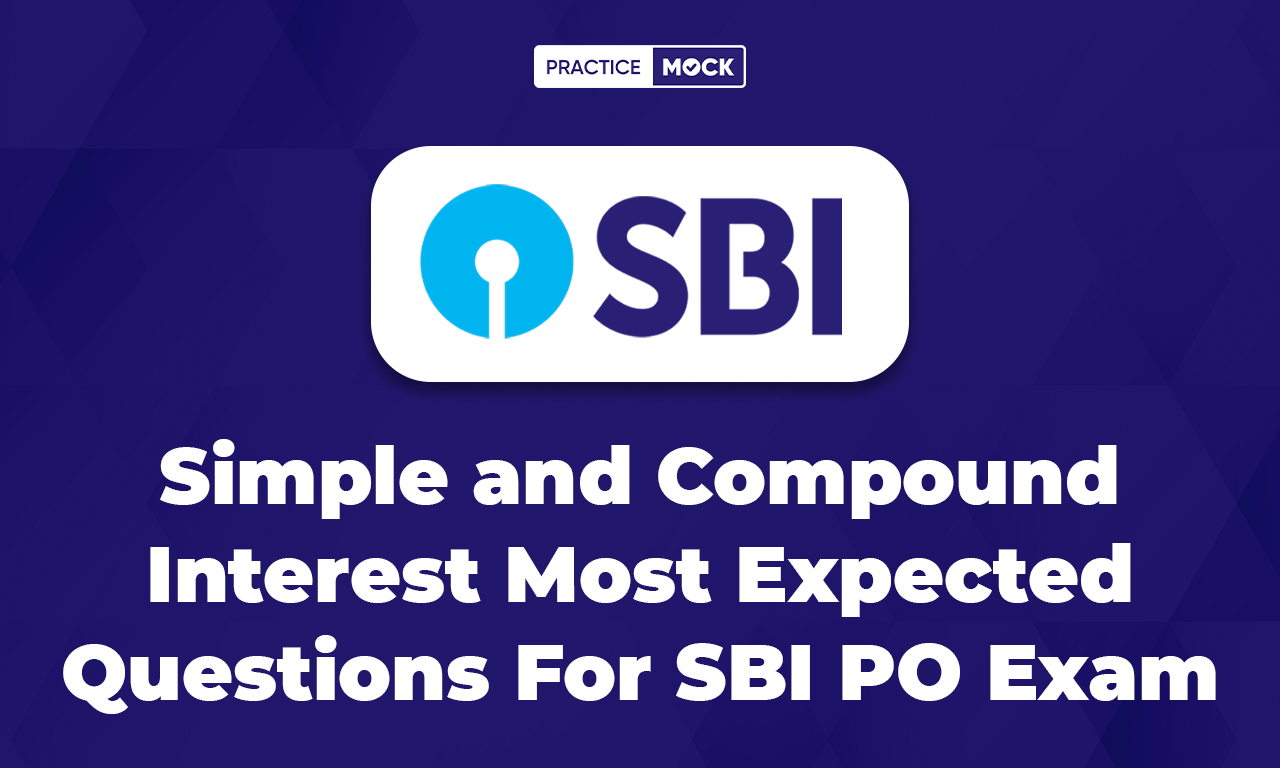Simple and Compound Interest For SBI PO Exam: The SBI PO exam is one of the most sought banking exams in India, and the Quantitative Aptitude section plays an important role in your success. Simple Interest (SI) and Compound Interest (CI) are among the key topics that every year appear in the exam. This article provides an overview of the SBI PO Simple interest and compound interest along with the free mock test and important questions and their detailed solution. Candidates can check all details about Simple and Compound interest in the article below.
What is Simple and Compound Interest
Simple Interest
Simple Interest is calculated on the original principal amount for the entire duration of the loan or investment. The formula for calculating Simple Interest is:

Where:
- P = Principal (initial amount of money)
- R = Rate of interest per annum
- T = Time period (in years)
Compound Interest
Compound interest is calculated on the principal amount and the interest that accumulates over time. This means that the interest earned each period is added to the principal amount, and interest is calculated on this new amount.

Simple & Compound Formula
Compound interest:
Interest = Amount – Principal
If Rs. ‘P’ is invested at a rate of ‘r%’ p.a. compounded annually for ‘t’ years, then the amount received after ‘t’ years will be = P × {1 + (r/100)}t
If the interest is not compounded annually, then
Effective rate of interest = Actual rate ÷ Number of times the interest is compounded in a year
Effective time period = Actual time period × Number of times the interest is compounded in a year
Simple interest:
If Rs. ‘P’ is invested at simple interest of ‘r%’ p.a. for ‘t’ years, then the amount received after ‘t’ years will be = P + {(P × r × t)/100}
And, the simple interest received = {(P × r × t)/100}
Relationship between simple interest (SI) and compound interest (CI):
When a principal (P) is invested at the rate of ‘r%’ p.a., then
Difference between SI and CI after two years = P × (r/100)2
Difference between SI and CI after three years = P × (r/100)2 × {(r/100) + 3}
Simple and Compound Interest Important Question PDF Link
Question 1: Find the difference between the compound interest and simple earned by a man, if he lent Rs. 64000 at the rate of 10% interest in both types of interest for 3 years.
A) Rs. 2012
B) Rs. 1632
C) Rs. 1848
D) Rs. 1984
E) Rs. 1932
Question 2: The total amount earned by the man from a scheme which offers simple interest at the end of 4th year and 5th year is Rs. 7984 and Rs. 8108 respectively. Find the amount invested by him in the scheme.
A) Rs. 7488
B) Rs. 7546
C) Rs. 7396
D) Rs. 7244
E) None of these
Question 3: Amir invested Rs. 18,000 in a scheme offering 20% compound interest for two years compounded annually. Find the interest earned by him.
A) Rs. 7,820
B) Rs. 7,920
C) Rs. 8,020
D) Rs. 8,120
E) None of these
Question 4: Raman deposited Rs. 16000 at 20% per annum compound interest and Rs. 12000 at 30% simple interest per annum. What will be the difference in the interest after completion of 2 years?
A) Rs. 180
B) Rs. 160
C) Rs. 120
D) Rs. 140
E) Rs. 150
Simple and Compound Interest Important Question PDF Link
Related Articles On SBI PO 2025 Exam
| SBI PO Exam Pattern 2025 | SBI PO Previous Year Question Paper |
| SBI PO Salary 2025 | SBI PO Syllabus 2025 |
| SBI PO Cut Off 2025 |
Simple and Compound Interest For SBI PO Exam FAQ
Simple Interest is the interest calculated on the principal amount only.
Compound Interest is the interest calculated on the principal and also on the accumulated interest of previous periods.
Candidates can download the Simple and Compound Interest Important Questions in this article.
- Sign Up on Practicemock for Updated Current Affairs, Free Topic Tests and Free Mini Mocks
- Sign Up Here to Download Free Study Material
Free Mock Tests for the Upcoming Exams
- IBPS PO Free Mock Test
- RBI Grade B Free Mock Test
- IBPS SO Free Mock Test
- NABARD Grade A Free Mock Test
- SSC CGL Free Mock Test
- IBPS Clerk Free Mock Test
- IBPS RRB PO Free Mock Test
- IBPS RRB Clerk Free Mock Test
- RRB NTPC Free Mock Test
- SSC MTS Free Mock Test
- SSC Strenographer Free Mock Test
- GATE Mechanical Free Mock Test
- GATE Civil Free Mock Test
- RRB ALP Free Mock Test
- SSC CPO Free Mock Test
- AFCAT Free Mock Test
- SEBI Grade A Free Mock Test
- IFSCA Grade A Free Mock Test
- RRB JE Free Mock Test
- Free Banking Live Test
- Free SSC Live Test



